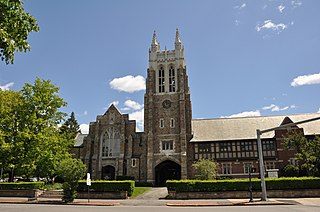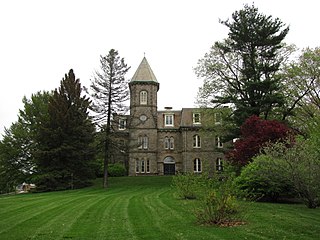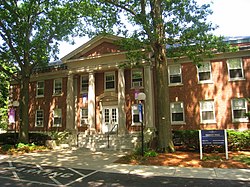
Moravian University is a private university in Bethlehem, Pennsylvania. The institution traces its founding to 1742 by Moravians, descendants of followers of the Bohemian Reformation under John Amos Comenius. Founded as a girls school in 1742, the College itself was founded as the Moravian College and Theological Seminary in 1807 and was accredited in 1863. In 2021, the College was elevated to a University. Moravian University uses the foundation of the Girls school as their foundation date which would make them the sixth-oldest college in the United States.

Andover Theological Seminary (1807–1965) was a Congregationalist seminary founded in 1807 and originally located in Andover, Massachusetts on the campus of Phillips Academy.
The Meadville Lombard Theological School is a Unitarian Universalist seminary in Chicago, Illinois.

Newton Centre is one of the thirteen villages within the city of Newton in Middlesex County, Massachusetts, United States. The main commercial center of Newton Centre is a triangular area surrounding the intersections of Beacon Street, Centre Street, and Langley Road. It is the largest downtown area among all the villages of Newton, and serves as a large upscale shopping destination for the western suburbs of Boston. The Newton City Hall and War Memorial is located at 1000 Commonwealth Avenue, and the Newton Free Library is located at 330 Homer Street in Newton Centre. The Newton Centre station of the MBTA Green Line "D" branch is located on Union Street.

Virginia University of Lynchburg (VUL) is a private historically black Christian university in Lynchburg, Virginia. The university is accredited by the Transnational Association of Christian Colleges and Schools and offers instruction and degrees, primarily in religious studies, including a Doctorate of Ministry program. The campus is a historic district listed on the National Register of Historic Places.

Old Queens is the oldest extant building at Rutgers University and is the symbolic heart of the university's campus in New Brunswick in Middlesex County, New Jersey in the United States. Rutgers, the eighth-oldest college in the United States, was founded in 1766 during the American colonial period as Queen's College. Queen's College was named for Charlotte of Mecklenburg-Strelitz, the daughter of a German duke who became the queen consort of British king George III. Old Queens is located on a six-acre hilltop city block bounded by Somerset Street, Hamilton Street, College Avenue and George Street that was previously an apple orchard. Donated to the college in 1807 by James Parker, Jr., this city block become known the Queen's Campus and is the historic core of the university. Because of this, by metonymy, the name "Old Queens" came to be used as a reference to Rutgers College and is often invoked as an allusive reference to the university or to its administration.
Newton Theological Institution was a Baptist theological seminary founded on November 28, 1825 in Newton Centre, Massachusetts.
Andover Newton Theological School (ANTS) was a graduate school and seminary in Newton, Massachusetts, affiliated with the American Baptist Churches USA and the United Church of Christ. It was the product of a merger between Andover Theological Seminary and Newton Theological Institution. In recent years, it was an official open and affirming seminary, meaning that it was open to students of same-sex attraction or transgender orientation and generally advocated for tolerance of it in church and society.

Bangor Theological Seminary was an ecumenical seminary, founded in 1814, in the Congregational tradition of the United Church of Christ. Located in Bangor, Maine, and Portland, Maine, it was the only accredited graduate school of religion in Northern New England

The First Unitarian Universalist Society in Newton occupies a prominent location at 1326 Washington Street in the heart of the village of West Newton in Newton, Massachusetts. Architect Ralph Adams Cram designed the church, Frederick Law Olmsted Jr. designed the grounds, the cornerstone was laid in 1905, and it was dedicated in 1906; it is one of the village's oldest buildings. The church is in Cram's signature Gothic Revival style, with buttressed walls and a blocky square tower with crenellations and spires. An enclosed courtyard is formed by an office wing, banquet hall, and parish house, which are built to resemble Elizabethan architecture with brick first floor and half-timbered upper level.

The Academy Hill Historic District is a historic district on Massachusetts Route 28 in Andover, Massachusetts. It encompasses the historic campuses of three important 18th and 19th century academic institutions, which shaped not only town but the nation's educational systems.

The Central Street District is a historic district encompassing the traditional heart of Andover, Massachusetts prior to the development in the later 19th century of the current town center. It consists mainly of residential and religious properties along Central Street, from Phillips Street in the south to Essex Street in the north. All of the listed properties have frontage on Central Street, even if their addresses are on one of the adjacent streets.

Colby Hall is an historic building on the campus of Andover Newton Theological School at 141 Herrick Road in the village of Newton Centre in Newton, Massachusetts. It was built in 1866 in a mixture of Second Empire and Romanesque styles. It was named for Gardner Colby (1810–79), who was treasurer of the school and also was the benefactor of Waterville College in Maine, which changed its name to Colby College in his honor. On January 30, 1978. it was added to the National Register of Historic Places.

The Henry I. Harriman House is a historic French château style house at 825 Centre Street in Newton, Massachusetts. Built in 1916 for Henry I. Harriman, it is one of Newton's most elegant 20th-century suburban estate houses. It is now part of the campus of the Boston College Law School. It was known as Putnam House, in honor of benefactor Roger Lowell Putnam, when the campus was that of Newton College of the Sacred Heart. It was listed on the National Register of Historic Places in 1990.

Alexander Rice Esty was an American architect known for designing many Gothic Revival churches in New England. His work also encompassed university buildings, public buildings, office buildings, and private residences across the Northeastern United States.

Hartwell and Richardson was a Boston, Massachusetts architectural firm established in 1881, by Henry Walker Hartwell (1833–1919) and William Cummings Richardson (1854–1935). The firm contributed significantly to the current building stock and architecture of the greater Boston area. Many of its buildings are listed on the National Register of Historic Places.

Gardner Colby (1810–1879) was a prominent businessman and Christian philanthropist. He is the namesake of Colby College in Maine.
Rev. Beniah Longley Whitman was the 11th president of Colby College, and later Columbian College.
Andover Newton Seminary at Yale Divinity School is an American seminary program founded in 2017 within Yale Divinity School and located in New Haven, Connecticut. It is the successor institution of Andover Newton Theological School (ANTS), the oldest graduate seminary in the United States and the nation's first graduate institution of any kind.

Rufus Sargent (1812-1886) was an American architect practicing in Newburyport, Massachusetts during the nineteenth century.





















